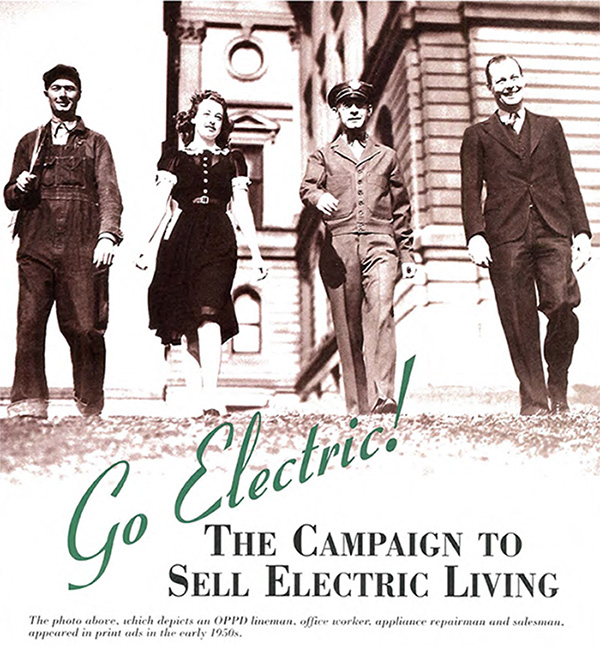Lincoln Electric System Annual Holiday Event With Local Zoo Fosters Customer Engagement
December 6, 2021
by Vanessa Nikolic
APPA News
December 6, 2021
Nebraska public power utility Lincoln Electric System (LES) partnered with the Lincoln Children’s Zoo (LCZ) to provide a holiday event for the community – Zoo Lights Powered by LES. The event offers an energy-efficient light show to the Lincoln community.
Zoo Lights Powered by LES was launched in 2019 and attracted 36,945 attendees. In 2021, the event continues to be LES’ main holiday engagement effort and remains one of the largest light shows in the area. The event is 100% lit by energy-efficient LED bulbs.

After LCZ transitioned from being open seasonally to open year-round, LES staff wanted to support the zoo’s new hours and approached LCZ staff with its idea to sponsor a community lighting event for the holidays. Both LES and LCZ saw the benefits of a community partnership.
The event continues to show many benefits to LES’ communications efforts from general brand awareness to customer outreach and community engagement. LES staff members volunteer by distributing handouts and answering customer questions during the event.
During the event’s inaugural year, the LES communications team developed a model gingerbread house to use as a platform to educate visitors about energy-efficient technologies, energy-saving tips, and rewards programs that LES offers. LES aims to expand its presence at the zoo and think of new ways to engage attendees.

LES says the event gives the utility a platform to speak to the community about electricity through the lens of holiday lights.
The “Zoo Lights” experience includes a 40-foot Christmas tree, over 30 lit animal silhouettes, holiday train rides, a tree canopy light walk, a 60-foot light tunnel, s’mores and hot chocolate stations, and more. Visitors can also take photos with two life-sized LES lineworker nutcrackers, Volts and Watts.

The event is open to the public through December 30 from 5:30 to 8:30 p.m. local time. For more information, visit LES.com/ZooLights.
Proceeds from Zoo Lights Powered by LES directly supports LCZ and its animals in the winter months.
To watch a preview of Zoo Lights Powered by LES, visit LES’ YouTube page.
Public Power Executives Detail Storage Project Benefits, Lessons Learned
December 6, 2021
by Paul Ciampoli
APPA News Director
December 6, 2021
Executives from public power utilities in North Carolina, Rhode Island and Minnesota recently detailed benefits and lessons learned from energy storage projects that their utilities have pursued.
The officials from Fayetteville Public Works Commission in North Carolina, Grand Rapids Public Utilities Commission in Minnesota and Rhode Island’s Pascoag Utility District, made their remarks during a session at the American Public Power Association’s (APPA) Public Power Forward Virtual Summit on Dec. 2.
Michael Kirkwood, General Manager at Pascoag Utility District, described a non-wires alternative project that “became a real money-saving option to avoid a large transmission expenditure that we were facing.” The project “fit in with some other reinforcements that we were doing on our system. The battery storage really made this possible and saved us a lot of money.”
Pascoag Utility District serves 4,900 customers in Pascoag and Harrisville, two villages in northwest Rhode Island. The PUD is connected to the outside world via two 5-mile 13.8 kV lines from investor-owned National Grid.
Peak load for the public power utility on the hottest summer days is about 13 megawatts. In 2018 and 2019, Pascoag Utility District started to reach the thermal limits of the main feeder line.
In 2019, Pascoag Utility District commissioned a system impact study that was completed by National Grid and offered several alternatives.
The public power utility determined that a non-wires alternative was the most cost-effective solution using a combination of substation enhancements and battery storage. The 3-megawatt/9-megawatt hour lithium-ion energy storage system is being built by Agilitas Energy.
The project has helped Pascoag Utility District avoid having to spend $6 million to $12 million “and if you look at that over 4,900 customers that’s a big nut to crack for a lot of years,” Kirkwood said.
The project will also increase reliability and reduce loading on the feeder lines, he noted.
Another panelist, Julie Kennedy, General Manager for Minnesota public power utility Grand Rapids Public Utilities, offered details on the utility’s solar plus battery storage project.
She noted that the project got its start in 2016 through a citizen initiative. A community solar project was initially considered, Kennedy said.
In late 2018, the public power utility presented a final report to its commission. “We said, you know what, it is a little bit difficult to make that subscription model work.” While the utility could have pursued that approach, “it really wasn’t meeting the hopes and desired outlook that we had had when we had our community outreach,” Kennedy said.
“What we did notice, though, was the parity in the pricing between solar only and the solar plus storage and so we started looking at those economics a little bit more closely and that is what caused us to add the energy storage.”
Along with US Solar and Grand Rapids Public Utilities, other parties involved in the project are Minnesota Power, a subsidiary of investor-owned Allete, the Itasca Clean Energy Team, and the City of Grand Rapids. US Solar is developing the two-megawatt solar array and one-megawatt/2.5-(megawatt?) hour energy storage battery on city-owned land near the Grand Rapids/Itasca County Airport.
Kennedy noted that installation of the solar panels at the site was completed in the fall. The storage battery “is, unfortunately, out at sea, still. We have been postponed with supply chain issues. Our next anticipated date is December 16. We are waiting to run our test energy. We are hopeful that it will be on site December 16,” with commissioning by the end of the year.
Meanwhile, Elaina Ball, CEO of Fayetteville Public Works Commission, detailed the utility’s community solar plus storage project.
“We were the first municipal community solar project in the state of North Carolina,” she noted. The project came online in 2019.
The 1-megawatt, 3,384 panel farm is located in northeast Cumberland County, adjacent to the utility’s Butler-Warner Generation Plant. In addition, the farm has 500-kilowatt battery storage. The battery is discharged 100% over two hours.
Ball said that the installed cost of the battery system itself “was a little over $900,000 and we expect about $5,500 in annual O&M costs just around the battery system and based on demand shaving that we’ve had, we expect our annual savings to be about $120,000. In a simple payback term, the battery is paying for itself in eight years.”
She said that “looking to the future, we want to add additional storage.” Ball noted that the utility’s wholesale contract allows for Fayetteville PWC to go up to 2 megawatts, “so we are in the process of adding another” one-and-a-half megawatts of storage.
“That’s really going to do two things. One, it’s going to be a four-hour discharge potential, which will give us much longer duration and give us an even better tool to hit that coincident peak window. But it’s also going to allow us to maximize our battery storage capacity. So we got our toe in the water, know how to operate this system” and the utility now wants to “push the capacity and we want to make sure that we’re getting as much value out of these resources as possible,” Ball said.
The utility is also studying additional community solar projects in its service territory. It is focused on looking at the economics of those projects, as well as “making sure that there’s customer demand to support additional resources in the community,” she said.
APPA Storage Tracker
APPA recently launched a Public Power Energy Storage Tracker, which is a resource for association members that summarizes energy storage projects undertaken by members that are currently online. The tracker is available here.
Calif. CCAs Issue First Ever Clean Energy Bonds Valued At More Than $2 Billion
December 6, 2021
by Paul Ciampoli
APPA News Director
December 6, 2021
Three California community choice aggregators (CCAs) have issued California’s first ever municipal non-recourse Clean Energy Project Revenue Bonds through the California Community Choice Financing Authority (CCCFA). The two separate bond issuances are valued at over $2 billion for thirty-year terms.
The three CCAs are East Bay Community Energy, Marin Clean Energy (MCE) and Silicon Valley Clean Energy. The two Clean Energy Project Revenue Bonds will prepay for the purchase of over 450 megawatts of renewable energy.
These transactions will reduce renewable power costs by almost $7 million annually for the first 5-10 years, according to the CCAs.
They noted that a Clean Energy Project Revenue Bond is a form of wholesale electricity prepayment that requires three key parties: a tax-exempt public electricity supplier (the CCA), a taxable energy supplier, and a municipal bond issuer.
The CCAs enter into long-term power supply agreements for clean electricity sources like solar, wind, geothermal, and hydropower.
The municipal bond issuer — in this case, CCCFA — issues tax-exempt bonds to fund a prepayment of energy that is to be delivered over 30 years. The energy supplier utilizes the bond funds and provides a discount to the CCA on the power purchases based on the difference between the taxable and tax-exempt rates. This discount is historically in the range of 8-12%, and minimum discounts are negotiated for each transaction.
The first of these bonds, which was issued by CCCFA for the benefit of East Bay Community Energy and Silicon Valley Clean Energy, was underwritten by Morgan Stanley. It successfully generated nearly $1.5 billion in proceeds, after having received an investment grade “A1” rating from Moody’s Investors Service and a “Green Climate Bond” designation from Kestrel Verifiers, making it the largest ever issuance of prepayment bonds for clean electricity.
The second transaction, issued by CCCFA for the benefit of MCE, was underwritten by Goldman Sachs. The bond sale produced approximately $700 million in bond proceeds. The issue received an investment grade “A2” rating from Moody’s and a “Green Climate Bond” designation from Kestrel Verifiers.
CCCFA was established in 2021 with the goal of reducing the cost of power purchases for member CCAs through pre-payment structures. The founding members of CCCFA include Central Coast Community Energy, East Bay Community Energy (EBCE), MCE, and Silicon Valley Clean Energy.
EBCE is a not-for-profit public agency that operates a community choice energy program for Alameda County and fourteen incorporated cities, serving more than 1.7 million residential and commercial customers.
MCE provides electricity service and programs to more than 540,000 customer accounts and more than one million residents and businesses in 37 member communities across four Bay Area counties: Contra Costa, Marin, Napa, and Solano.
Silicon Valley Clean Energy provides electricity from renewable and carbon-free sources to more than 270,000 residential and commercial customers in 13 Santa Clara County jurisdictions.
The American Public Power Association has initiated a new category of membership for community choice aggregation programs.
Phillips Sworn In As FERC Commissioner
December 4, 2021
by Paul Ciampoli
APPA News Director
December 4, 2021
Willie Phillips on Dec. 3 was sworn in as a member of the Federal Energy Regulatory Commission (FERC) for a five-year term that ends June 30, 2026.
Phillips was nominated to FERC by President Biden in September 2021 and confirmed by the Senate on November 16, 2021.
Phillips, a Democrat, returns FERC to its full complement of five commissioners, and he provides the Democrats with a 3-2 majority.
Before joining FERC, Phillips was the Chairman of the District of Columbia Public Service Commission. He previously worked as Assistant General Counsel for the North American Electric Reliability Corporation (NERC), and also worked for two law firms.
New River Light and Power Green Power Program Nominated for Cleantech Innovation Award
December 1, 2021
by Vanessa Nikolic
APPA News
December 1, 2021
North Carolina public power utility New River Light and Power’s (NRLP) Green Power Program has been nominated for a 2021 Cleantech Innovation Award from the Research Triangle Cleantech Cluster (RTCC).
RTCC is an initiative of business, government, and nonprofit leaders focused on advancing the growth of the regional and statewide clean technology (cleantech) economy.
With its Third Annual Cleantech Innovation Awards, RTCC aims to recognize the contributions of the companies, organizations, and individuals that have advanced cleantech solutions across North Carolina. The awards are judged by leaders from the cleantech industry and public sectors.
NRLP’s Green Power Program is nominated under the Cleantech Impact: Energy category which recognizes an energy project that applies cleantech to create positive impacts for the environment, economy, and residents. Projects may include innovations to existing grid infrastructure to enhance resiliency, renewable energy installations, microgrid deployments, or innovative energy efficiency programs.
The Green Power Program provides residential and commercial customers with the opportunity to purchase clean energy. NRLP customers can choose to purchase blocks of hydroelectric power to offset their monthly carbon-based electric use. Each block costs $5 and represents 250 kilowatt-hours (kWh) of clean energy.
NRLP launched the program and made it available to customers at the beginning of August 2021. Prior to its launch, plans to offer the program were in the works for a number of years as customers became more interested in renewable energy.
The utility conducts customer surveys every three years through ElectriCities of North Carolina. NRLP’s 2020 customer survey found that 65% of its residential customers indicated they would be willing to pay an additional $5 on their monthly bill to obtain 30% of their electricity from renewable sources.
NRLP public communications specialist Chris Nault said the nomination recognizes and supports the utility’s commitments to providing clean energy and outstanding service to its customers and the community.
“This nomination for a 2021 Cleantech Innovation Award is an honor for NRLP and App State,” Nault said. “It is great to know that our hard work and service to our customers is being recognized by an organization like the Research Triangle Cleantech Cluster.”
The winners in each category will be announced at an awards ceremony on Wednesday, December 8 in Raleigh, North Carolina.
For a complete list of nominees, visit https://www.researchtrianglecleantech.org/cleantechawards2021.
NRLP was previously nominated for a 2019 Cleantech Innovation Award for Grid Innovation related to the deployment of technology on its electric grid. Additional details on the 2019 nomination can be found here.
NRLP is an electric utility, owned by Appalachian State University, that serves nearly 9,000 residential and commercial customers in Boone, North Carolina and the surrounding community. The Green Power Program is made possible through NRLP’s new wholesale power agreement with Carolina Power Partners, effective January 2022.
The NRLP Green Power Program is a component of Appalachian State University’s commitment to reduce its use of fossil fuels and provide an option for NRLP customers to do the same.
Ditto Urges Senate To Retain Direct Pay Energy Tax Credit Provisions
December 1, 2021
by Paul Ciampoli
APPA News Director
December 1, 2021
The U.S. Senate should keep the provisions of the Build Back Better Act that will ensure that all electric utilities and their customers benefit from tax incentives encouraging investments to transition to cleaner energy technologies, investments that are needed to reduce greenhouse gas emissions, Joy Ditto, President and CEO of the American Public Power Association (APPA) said in a Nov. 30 letter to Sen. Ron Wyden, D-Ore.
“Similar to the direct pay provisions of your Clean Energy for America Act (S. 2118), enactment would mean that all utilities, not just for-profit utilities, can directly benefit from these energy tax credits,” wrote Ditto in her letter. “This will make these incentives fairer and more effective.”
Wyden is Chairman of the Senate Committee on Finance.
Ditto noted that federal tax expenditures are the primary tools that Congress uses to incentivize energy-related investments.
However, tax-exempt entities– including public power utilities, rural electric cooperatives, and other not-for-profit entities — cannot directly claim such incentives.
“In effect, not-for-profit utilities serving nearly 30 percent of utility customers in the U.S. are effectively locked out of owning facilities being incentivized by such credits – wind, solar, energy storage, etc. This explains why 80 percent of the nation’s (non-hydropower) renewable energy generating capacity is owned by merchant, for-profit, generators,” Ditto said.
The Build Back Better Act (H.R. 5376) addresses this inequity by allowing the direct payment of energy tax credits – including production, investment, and carbon capture tax credits – to any entity that owns the project, she went on to say in the letter.
“This would remove the financial disincentive for public power utilities to own such facilities, which are needed to transition to cleaner energy technologies needed to address climate change. It would also allow the full value of these credits to pay for additional clean energy investments that will benefit the more than 90 million Americans nationwide served by tax-exempt, not-for-profit electric utilities,” wrote Ditto.
“We strongly encourage Congress to take the steps needed to make these tax credits both more effective and more equitable for public power utilities and the communities they serve.”
The House passed the Build Back Better Act in November, sending it to the Senate for consideration. Senate Majority Leader Charles Schumer, D-N.Y., has indicated that he would like the Senate to take up the reconciliation bill in December.
Planning Is Underway For Project That Will Bring Power To Navajo Nation Residents
November 30, 2021
by Paul Ciampoli
APPA News Director
November 30, 2021
Planning for Light Up Navajo III, which will connect Navajo Nation families to the power grid, is underway. Public power utilities are encouraged to consider participating in Light Up Navajo III, which will start in the spring of next year.
The American Public Power Association (APPA) is working with the Navajo Tribal Utility Authority (NTUA) to help volunteers continue to bring electricity to families in need.
Light Up Navajo III is scheduled to take place from April through June of 2022.
“This project has become a godsend for so many families that are waiting for the day to be able to store fresh food in a refrigerator, to be able to turn on the lights when the sun goes down and the young ones can do their homework without using a flashlight,” said NTUA General Manager Walter Haase. “It is our hope that our sister APPA companies will send their crews to help bring positive change. For every family we connect, there is another one waiting.”
In 2019, NTUA partnered with APPA to create an innovative, pioneer project called Light Up Navajo. The goal was to connect Navajo homes to the electric grid. There were 138 visiting line workers who traveled to Navajo Nation for the six-week pilot project. Electricity was extended to 233 regional families. The success of the pilot project paved a path for future Light Up Navajo projects.
In August 2019, NTUA officials said there would be another year of “Light Up Navajo” based on the outcome of the pilot project. NTUA was preparing for Light Up Navajo II for spring 2020. However, citing growing uncertainty tied to the COVID-19 pandemic, NTUA ipostponed the Light Up Navajo II project in 2020.
In an August 2021 episode of APPA’s Public Power Now podcast, Delaware Municipal Electric Corporation’s Kimberly Schlichting, Gary Johnston of the Lewes Board of Public Works in Delaware, and Joshua Little of the Town of Smyrna, Delaware, discussed the Light Up Navajo project.
Interested public power utilities should contact lightup-navajoproject@ntua.com for more information on this important event.
Wells Fargo, D.E. Shaw Close Tax Equity Deal For Solar-Storage Project
November 30, 2021
by Peter Maloney
APPA News
November 30, 2021
Units of Wells Fargo and D.E. Shaw this week closed on a tax equity financing for a solar-plus-storage project in McKinley County, N.M.
The Arroyo Solar and Storage project is a 300-megawatt (MW) solar array combined with a 150 MW, 600-megawatt hour (MWh) battery energy storage system that was originally developed by Centaurus Renewable Energy.
Centaurus closed on a $70 million construction bridge loan for the project from Voya Investment Management in late June. D. E. Shaw Renewable Investments (DESRI) acquired the project from Centaurus in September.
The first phase of the Arroyo project is expected to begin commercial operation in June 2022 with full operation expected in the fall of 2022.
Arroyo is currently under construction with efforts being made to hire workers locally and from the Navajo Nation. The project is expected to generate as many as 250 jobs during construction.
D. E. Shaw and Wells Fargo’s Renewable Energy & Environmental Finance group have now closed on the long-term tax equity financing for the project. The value of the deal was not disclosed.
A tax equity financing usually involves a financial entity taking an equity stake in the project company in return for revenue streams and tax credits generated by the project.
At the end of a period of time, the tax equity investment in the project usually reverts or is bought back by the original developer or the project sponsor.
For the Arroyo project, Wells Fargo is the tax equity investor, spokeswoman Trina Shepherd said via email. D.E. Shaw provided the cash equity and is the project sponsor and has an option to buy out the tax equity investor at the end of the deal.
Solar-plus-storage projects are eligible for investment tax credits (ITC) for both the solar and storage portions of a project, if certain criteria are met. The ITC percentage for projects beginning construction in 2021 or 2022 is 26 percent of the value of the project.
The Arroyo project is Wells Fargo’s first tax equity investment in a project with co-located battery storage. It is D.E. Shaw’s first solar project with co-located battery storage to enter construction and financing.
The Arroyo project has two offtake contracts with Public Service Company of New Mexico, one for the solar output and one for the output from the storage system. The combined output of the project will supply a portion of the replacement capacity needed to retire the 847-MW San Juan coal plant in San Juan County, N.M., which is scheduled to retire at the end of 2022.
Sundt Construction is building the Arroyo solar facility. ECI of Billings, Mont., provided the design for the substation and switchyard that will be built by its EPC Services subsidiary. Tesla will supply and commission its Megapack battery units for the facility, and New Mexico-based Affordable Solar Installation will construct the battery energy storage system. SOLV Energy and Tesla will provide ongoing operations and maintenance services to the facility once it is in operation.
Nebraska’s Omaha Public Power District Celebrates 75th Anniversary
November 30, 2021
by Paul Ciampoli
APPA News Director
November 30, 2021
Nebraska public power utility Omaha Public Power District (OPPD) on Dec. 2 will celebrate the 75th anniversary of its creation.
“OPPD has powered the communities it serves through wars, floods and pandemics,” OPPD’s newsletter, The Wire, notes in an article about the anniversary.

The history of OPPD dates back to 1917, when the Nebraska Power Company was incorporated. On June 1 of the same year, the newly formed company acquired the property of the Omaha Electric Light and Power Company. In 1946, its customers numbered 83,507, gross revenues totaled $10,828,000, kilowatt-hour sales were 552,000,000 and generating capability had reached 119,000 kilowatts.
On Dec. 2, 1946, the state legislature created OPPD as a political subdivision of the state of Nebraska, which acquired the properties operated by the Nebraska Power Company.

In January 1965, the Eastern Nebraska Public Power District merged with OPPD, doubling the size of our service area to 5,000 square miles. With the merger, four counties were added to OPPD’s service area, which now covers all or part of 13 counties in southeastern Nebraska.
Click here for milestone and anniversary-related content posted on The Wire’s webpage.
A 75th anniversary video OPPD created for an employee celebration is posted here,
EPA And Department of Army Issue New Proposed WOTUS Definition
November 30, 2021
by APPA News
November 30, 2021
The U.S. Environmental Protection Agency (EPA) and the U.S. Department of the Army have proposed to reestablish the pre-2015 definition of “waters of the United States” (WOTUS).
The proposed rule is updated to reflect U.S. Supreme Court precedent, the agencies said.
The American Public Power Association (APPA) in September 2021 submitted comments in response to a request for recommendations to revise and refine the regulatory definition of WOTUS. In those comments, APPA advocated that a new definition must draw clear jurisdictional lines, provide needed predictability for the regulated community, and be consistent with the Clean Water Act and Supreme Court precedent.
In 2021, U.S. district courts in Arizona and New Mexico vacated the prior administrations Navigable Waters Protection Rule (NWPR). In light of the court actions, the agencies have been implementing the pre-2015 regulatory regime nationwide since early September 2021.
The agencies have indicated their intention to continue to consult with stakeholders to refine the definition of WOTUS in both implementation and future regulatory actions.
EPA and the Army are interpreting WOTUS to mean the waters defined by the longstanding 1986 regulations.
Therefore, in the proposed rule, the agencies interpret the term WOTUS to include:
- Traditional navigable waters, interstate waters, and the territorial seas, and their adjacent wetlands;
- Most impoundments of WOTUS;
- Tributaries to traditional navigable waters, interstate waters, the territorial seas, and impoundments that meet either the Army relatively permanent standard or the significant nexus standard; wetlands adjacent to impoundments and tributaries, that meet either the relatively permanent standard or the significant nexus standard; and
- “Other waters” that meet either the relatively permanent standard or the significant nexus standard.
The agencies interpret the significant nexus standard to mean “waters that either alone or in combination with similarly situated waters in the region, significantly affect the chemical, physical, or biological integrity of traditional navigable waters, interstate waters, or the territorial seas.”
Another amendment to the older regulations is to the term “relatively permanent standard,” which has been updated to mean waters that are “relatively permanent, standing, or continuously flowing and waters with a continuous surface connection to such waters.”
The proposal maintains the waste treatment system exclusion, returning to the 1986 regulatory version of that exclusion with ministerial changes made in the NWPR. The proposal would remove the favorable definition of waste treatment system that was codified in the NWPR.
For more information on the proposed rule and registering for the virtual public hearings, click here.
